#cat guide
Text
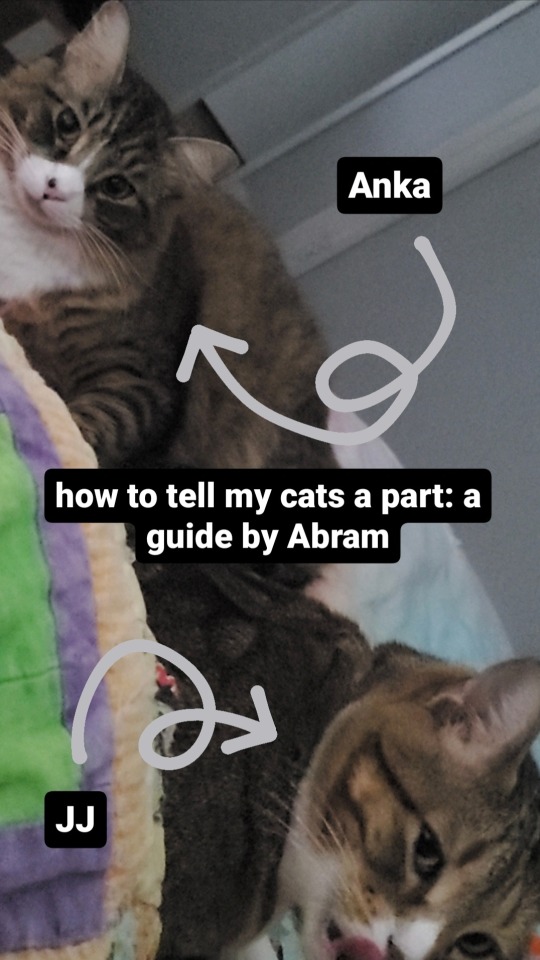



a helpful guide bc i know my cats look a bit similar and i tend to post pictures of them together with little explanation about who is who.
clicking the images may make them easier to read
#im cat posting today#im also laughing that anka's page turned out very chaotic compared to JJ's and like. that's so true#what an accurate metaphor for them#also tumeric is so very sweet and if it wasn't for the 2 pet policy iwoukd definitely have taken him in#this is the second time I've had him follow me to the building. this time he had climbed the stairs to my apartment with me#and we sat outside my door for a while#i gave him a treat and then had to go inside cus this was after work#he is Not My Cat but he definitely wanted to come inside with me cjsjjfjs#anka the banshee#sir jj the cat#cat guide#not tumeric#shh ac
27 notes
·
View notes
Text
Hi. My main blog is @ifsobblewereafairytype.
You might recognize my cats from @cats-and-confusion. That's my old blog.
I have anxiety and a low people-battery. You can talk to me but I'd rather you didn't unless absolutely necessary.
I don't care if you repost or reblog. I might dump art here sometimes. Or make a different sideblog for that. I don't know yet.
Cat guide:

-Ash
He's the second youngest, and Sora's brother. His household nickname is Ashhole. You'll never guess why.

-Sora
The youngest. He acts like it too. He's my beautiful baby snuggly spazzy son. He's also a little shit, and my favorite.

-Reeses
The second oldest, and inarguably the biggest. A snuggle cat. A facehugger. She likes to nap in everyone's beds and make sure the boys have clean fur. Despite being the biggest she's absolute dogshit at fighting.

-Cocoa
The oldest. I'm pretty sure she has anxiety. She's gotten pretty comfortable with us over the years though, and now she's the household box cat. A new box in the house? She's in it. An open box anywhere? She's in it. A box with a lid? She's on top of it. A laptop? She's on your keyboard. A stack of important papers? Hers now. She also has resting angry face and is rather quiet.


-Neighborhood cats
I don't have their names but I see them around and they let me pet them. There are others but I either don't have pictures or haven't gotten close enough to see or pet them properly.
2 notes
·
View notes
Text
Cat Body Language and Vocalizations: What They Mean and How to Respond
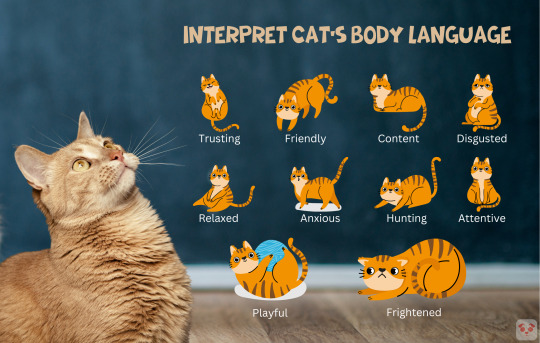
Do you want to understand what your cat is trying to tell you with their body language and vocalizations? In this article, you will discover how to decode your cat's signals and what they mean. You will also learn how to communicate better with your cat and avoid misunderstandings. Whether you are a new cat owner or a seasoned cat lover, this article will help you speak cat like a pro and bond with your feline friend.
#cat body language#decode your cat#cat communication#feline friends#cat guide#cat lovers#cat behavior
3 notes
·
View notes
Text

a quick guide i made for some friends since im the designated cat artist™️
0 notes
Text
Herb Guide: Deaf Warriors and Hearing Disabilities
UPDATE 1: Added more harshness to the lipreading section based on initial feedback; minor rewording of some lines!
A reference for Warrior Cats fans creating characters with hearing loss, blending human advice with cat biology, written for an in-universe perspective on living with and managing such disabilities.
AKA Bonefall casts Spell of Stop Being Weird About Snowkit on all amoebas in 500 mile radius

[ID: A headshot of three cats, a brown tabby with a shredded ear (Strikestone), a solid white cat with blue eyes (Stonewing), and a gray cat with a mane (Dovewing).]
In the five Clans, hearing loss is both one of the most common sensory disabilities, and one of the most intense to adapt to. Through any mix of simple infections, birth abnormalities, or even just getting older, any given Clan can expect at least 1 in 4 of its cats to have some form of hearing loss.
Hearing loss is any impaired ability to hear, defined as not being able to hear noises under 20 decibels. Deafness is "profound" hearing loss, which means their hearing STARTS at a noise that is 81 decibels (ex: motorcycle, middle-distant clap of thunder) or louder. Most deaf people can still hear slightly, but sound is "muffled" and they can only hear VERY loud noises.
Hearing loss = Any impaired ability to hear. Normal hearing is 20 DB or lower.
Hard of Hearing (HOH) = Mild to severe hearing loss; starts between 21 DB and 95 DB.
Deaf = Profound hearing loss at 95 DB or higher; a clap of thunder is a quiet whisper.
MOST hearing loss will affect one ear more strongly than the other, and the cat will be HOH. The vast majority of cats with a hearing disability will still be able to understand their Clanmates, if they're just spoken to louder and more clearly. Cats who are born deaf (congenital deafness), however, tend to have profound hearing loss which affects their ability to understand speech.
Cats rely on their hearing and sense of smell much more strongly than they do on their eyesight. With hearing that's 4x more sensitive than a human's and can differentiate between 1/10th of a pitch, a Clan's healer would recognize hearing loss as a disability long before humans would even notice a problem.
Since hearing loss starts with the high-pitch noises that prey makes, like squeaks and chirps, hearing loss is a major reason for a senior warrior to begin to consider retirement. However, with proper support and accommodation, ANY warrior could adapt to this disability; Especially cats born deaf and younger HOH warriors with lots of time to re-learn.
This guide covers;
Common Causes
Traits and Challenges of Hearing Loss
Communication: Signs, lipreading, and more
Unique Challenges Clan-by-Clan
Sources are linked in a separate post, here, and linked again at the very bottom!
(note: this guide doesn't cover devices of any kind, but one of many reasons why cochlear implants are controversial is because an implant will destroy that remaining hearing. They aren't hearing aids; hearing aids amplify sound. Aids and implants are two different things)
Common Causes
There are DOZENS of ways to destroy the incredibly sensitive ears of a cat. ANY infection or injury can lead to permanent damage. That can include,
Injury gone sour, from battle, hunting, accidents, etc
Concussion, or a hard enough blow to the ear
Ear Mites, especially if the cat can't stop scratching it
Swimming in cold or dirty river water
Fungal or bacterial infections
Allergies, which can lead to sinus infections. Even an infection in the mouth or throat can spread to the ear!
There doesn't even need to be an infection. Around the ages of 7 - 11, a senior warrior may begin to gradually lose their hearing. Sometimes, through genetic factors or degenerative disease within the ear, an even younger warrior will lose it for "no reason."
It just happens, and it's incredibly common. They will usually begin to notice it when they stop being able to hear and hunt small rodents, because hearing loss will start with high-pitched noises.
Healers can do very little about this, besides attempting to clean any wax out of the ear canal with flax oil and a dab (such as moss, wool, or cloth). There are SO many ways for it to happen and so little in the way of treatments, that it's practically inevitable.
The majority of hearing loss is from infection or disease, but the most predictable way to see deafness in the Clans is in kits born white with blue eyes. In fact, ALL pure white cats are more prone to being born deaf!
Pure white without blue eyes: 17% to 22%
White with a single blue eye: 40%
(and usually on the side of the blue eye)
White with two blue eyes: 65% to 85%
In an afflicted kit, the inner ear will rapidly degenerate. They typically lose most of their hearing by their 4th day, and will only be able to faintly hear extremely loud noises.
Of course, there's also various other birth defects that can result in deaf and HOH kits, even if they aren't white with blue eyes. The ear canal and hearing organs can just not form correctly! Any kit could be born with hearing loss, and they can have any type!
If the loss came from injury or severe infection, chronic pain in the inner ear is also common. Nothing can be done about this besides painkillers such as poppy seeds. This condition is rare in born-deaf cats.
Most cats with hearing loss will also permanently hear a repetitive, single-note sound. For most it's a faint, tinny "ring," but others can hear hissing, crackling, or humming in high or low pitch.
At first, this constant noise can be distracting or even debilitating, preventing them from focusing or sleeping, until... you just get used to it.
There is no way to turn the noise off. It can get worse or better, but it's forever. Sleeping and not being stressed out will help, but over time, they typically learn to tune it out. Being reminded of it is usually annoying, just like when someone reminds you about manual breathing.
(We call this condition tinnitus. It is up to you what you would like your cats to call it, the same way they refer to pneumonia as greencough. Tinnitus is a LOT broader than this little snippet, but this is not a guide about tinnitus, this is about hearing loss)
So to summarize that,
There's a billiondy-million ways to damage one's hearing.
Losing your hearing from age or disease usually results in being hard of hearing (HOH) as opposed to deaf, and is likely to affect one ear more than the other.
It starts with high-pitched noises like rodent squeaks.
Cats born white with blue eyes have a massive chance of being born deaf; their inner ear degenerates.
But, any kit could be born with any type of hearing loss, not just deafness.
Most cats with hearing loss will hear a distracting, repetitive noise. They just learn to tune it out.
Traits and Challenges of Hearing Loss
Hearing impaired cats are LOUD.
Even warriors who have mild hearing loss will often end up speaking much louder so they can hear themselves, or not notice the sounds they're making as they shift around in their nests, scuffle sand at the dirtplace, or trample through crunchy leaf litter.
If one of their ears is better than the other, they'll usually try to stand with their "good side" facing any speakers or other sources of noise. They might appear to be constantly standing at an angle, with their head turned towards the sound. It might be so second nature that they don't realize they're doing it.
Plus, a cat with hearing loss in only one ear will lose their hearing's "distance perception," the ability to pinpoint a sound's location. EXACTLY like how losing the sight in one eye causes the loss of "depth perception," they will have difficulty telling how far away a noise actually is.
Warriors who lose their hearing later in life typically have years of experience in knowing how prey behaves and what sorts of actions make noise; but cats born deaf have to be taught this.
Instead, born-deaf cats tend to associate "sound" with "vibration." Echoes, rumbles, and the sensation of their own humming or laughter can feel very pleasurable. Their whiskers are so sensitive that they can even feel drafts of air from someone speaking in front of them! Because of that, cats with impaired hearing do better with low, rumbling "sounds" rather than high-pitched ones; even when they can't hear either. They can feel lower pitched noises.
(NOTE: Decibels are the measurement of volume, and Hertz are the measurement of pitch. These are different things, NOT interchangeable. HIGH pitch and LOW volume are lost first.)
This is why hunting is so difficult when cats begin to lose their hearing. Their sense of smell and sight can be perfectly intact, but a lot of how a cat hunts is in listening for delicate little sounds and balancing them in both ears to figure out prey's exact location. So, when a cat is learning to hunt without their hearing, they have to rely on their other senses and keep their whiskers low, dusting the ground with their chops and front paws, in hopes of their quarry making a vibration they can feel.
IMPORTANT: Don't forget that cats have carpal whiskers! They are short whiskers on the front paws of a cat, used primarily for "grappling" with other cats and struggling prey. They are less sensitive than facial whiskers, but still very useful for a hearing impaired warrior.
"Dusting," keeping the face low, is still more effective than relying entirely on "Sweeping" movements with the paws.
The younger the cat is, the more time they will have to practice and master this. Cats born deaf, who have never relied on hearing before, are usually better hunters than older warriors learning completely new techniques.
But. Clan cats aren't the only danger in the forest.
A warrior who is deaf or hard-of-hearing will not hear danger approaching, and is easy to sneak up on. Even if they keep themselves completely quiet, an intelligent fox or an enemy warrior can launch an unexpected attack on their unsuspecting target. The wilderness is dangerous, and it's not feasible to keep one's whiskers pressed to the ground at all times, even if vibrations did carry far enough to detect such danger before it's too late.
So, it would be recommended for warriors with hearing loss to not wander too far without a hearing Clanmate capable of alerting them to sounds.
They also will have a VERY difficult time acting as part of a "battalion," in large-scale battles.
In fights with dozens of entangled warriors, while they're focused on fighting the cat in front of them, they will have a hard time hearing commands. Even if well-trained in visual cues like tail signs, deaf and HOH warriors might fail to respond to yowled orders like, "RETREAT" or "SECURE THE ENTRANCE."
Even if the warrior isn't fully deaf, battles are loud and chaotic! It's very likely that such orders would get lost in the clamor of hissing and screeching cats, if the cat has any difficulties with hearing at all.
In summary,
Cats with hearing disabilities are loud.
Hearing loss in one ear will cause the loss of distance perception, and they will often stand at an angle with their good ear facing the noise.
If they were born deaf, they have to learn what makes noise.
Highly tactile, they tend to rely on whisker-sense to "replace" their hearing.
Keeping their facial whiskers low to feel for vibration, "dusting," is a very useful technique.
"Sweeping" with the carpal whiskers is also useful, but less so than "dusting."
They are in increased danger from things sneaking up on them, and shouldn't go anywhere unsafe without a buddy.
Following battle commands in large-scale battles will be difficult or nearly impossible, making them bad "team players."
Communication: Signing, lipreading, and more
(psst! @twiigbranch has a free-to-use version of pawspeak if you credit them!)
Since the majority of these cats lost their ability to hear later in life, most warriors with hearing loss will speak "normally." By "normally," that means they will talk the same way they did their whole lives, just louder so they can hear themselves better.
Over many years, they may begin to stop enunciating their words, 'slurring' their sentences, and their pitch may be a little off. Even then, it's rare that a Clanmate would be able to "tell" they have hearing loss just from their cadence.
But, meanwhile, cats who are born deaf will have a very complicated journey with speech.
It's PIVOTAL for the kit's development that the family and the Clan takes an interest in trying to communicate with them. Deaf children often become isolated from communities that don't seem to care about them, the same way any other alienated child would. This can result in trauma, lack of self-confidence, and behavioral issues.
Even if your project doesn't have Pawspeak (or doesn't have it yet!), kittens WILL find ways to communicate with their family and Clan. Sign language can evolve organically from home signs, unique gestures that will rise for a deaf child to speak with their family. BUT, the sooner they're introduced to a true sign language, the better they will be able to communicate.
Sign languages can also die naturally, simply fading away if the next few generations don't keep them alive. It's possible for the Clans to have gone through a few, over the years!
(Note: Sign languages are full languages, not just "physical versions" of a spoken one. American Sign Language and British Sign Language are from totally different families, even further from each other than English and Russian!)
It is also possible for cats born fully deaf, who have never heard words, to learn how to speak verbally... but, this takes a LOT more time and effort than using a sign language.
Teaching a deaf warrior how to say words is not quick, or easy, and is a very physical process. It involves a lot of dedicated practice time back-and-forth, with the apprentice placing their paw on their mentor's throat to feel their voice, and being coached on how to mimic the exact inflections of every word. It can be very repetitive, and very boring.
Even with lots of training, speakers born deaf have a noticeable "accent." They pronounce consonants better than they do vowels (aeiou), and often lack tone and inflection. Each warrior is an individual, and using a speaking voice is a skill some will be better at using than others.
Lipreading is very difficult. Most warriors born deaf will never learn how to do this, or even want to, as it takes an immense amount of time, effort, and tutoring. It will be more common for cats with more moderate hearing loss, especially if they lost their hearing later in life.
These are REQUIRED for a proper lip reading;
Clear view of the face.
If the speaker is too far away, moving around, covers their mouth, stands in a dark place, or has their back turned, their lips can't be read. There are many ways that the view of the face could be obstructed.
Slow, clear speaking.
If they're talking too quickly and mumbling their words, it will be extremely difficult to catch all of what they said. A better lip reader will be able to read faster.
Mental awareness.
A cat who is tired to exhaustion, unable to focus, or not expecting to be spoken to will not be able to process what's being said. Lipreading is an action that takes brainpower.
MOST IMPORTANTLY: A single speaker, not overlapping with others.
Lip reading is nearly useless during clanwide arguments. If there's tons of cats talking over each other, shouting out and interrupting, responding to unseen lips in the crowd, or even if an important speaker is just at a bad angle for the deaf warrior's line of sight to catch, they will not be able to catch everything.
Lipreading is also an action that takes focus. If the cat is tired, unable to concentrate, or isn't expecting to have to read lips, they won't be able to process what words the mouth was forming. It works best one-on-one, in clear lighting, looking straight ahead at the speaker... and even then, the BEST lipreader might only catch 40% to 50% of the words said.
So, it's truly reading. Interpretation. It isn't straightforward like language is. From, "I see a herd of deer, all of them are bucks" they might only catch, "...a... deer... of them... bucks." They will have to guess the meaning based on context!
(Look into a mirror. Quickly chant "Red right wrong" three times. Do you see how similar your lips look to form those words when you're not trying to clearly enunciate them? That's what lipreaders deal with.)
So, while there are other options, a sign language is absolutely the best choice if possible in your setting. Especially for cats who were deaf from birth, sign language is the ideal solution.
VERY IMPORTANT TIPS FOR WRITING A HEARING DISABILITY:
Please avoid them speaking with broken grammar, in third person, or with overly simplistic vocabulary, as if they are a toddler or a caveman. If a deaf cat is taught to speak, they will also learn grammar.
BAD: "Examplefur go hunt. Me catch mouse good."
OK: "I'm going hunting. I'm good at catching mice."
They will not suddenly "forget" how to speak if they lose their hearing, unless they have another condition such as brain injury.
Lip reading is inferior to signing.
They cannot perfectly catch every single word spoken in all conversations via lipreading, especially when the speaker isn't making an effort to include them, or it's during a disorganized group argument.
In ideal conditions, 30% to 40% of the words spoken will be picked up, and the reader will "fill in" the missing vocab with guesswork.
Teaching a deaf cat to speak verbally is a dedicated process, not something they easily "pick up."
Cats born deaf will almost never pick up lipreading, it is more common in milder forms of hearing loss.
Showing hearing clanmates making an effort to include hearing-impaired warriors, like doing translations or just making sure they understood everything, is massively appreciated.
A good culture around hearing loss is the best thing in the entire world for these cats. Support, respect, and acceptance are sincerely the most important factor in how well a hearing impaired warrior adapts with their disability.
So with that in mind, let's also explore the unique challenges in the terrains and culture of each Clan.
Unique Challenges Clan-by-Clan
Because of the nature of this disability, certain Clans are going to be more difficult for a hearing impaired warrior to function independently in, both in terms of environmental hazards and of culture.
Deaf and HOH warriors will not hear the sounds they're making if they step on noisy terrain or accidentally rustle nearby plants. Some enemies also rely more on stealth to attack their targets than others, and some territories will provide more places for prey and predators to hide. Water-related hazards will naturally cause there to be MORE disabled cats in some Clans more than others, which could mean that there will be less stigma and better community.
Environment means a lot to a cat with hearing loss!
RiverClan
Because this Clan is notorious for swimming in the river, they would have a massively higher rate of hearing loss (and scent loss) than other Clans; ESPECIALLY in late autumn and winter. This also means their healers would be MUCH more experienced with treating ear problems in general; but that's a subject for another guide!
(to answer a stray question before I eventually make that guide: RiverClan can make primitive earplugs out of beeswax to protect their hearing, but may need to trade with ThunderClan to acquire that.)
The important thing to note is that compared to other Clans, RiverClan has the highest rate of having HOH warriors. This means that there would be better support systems for hearing loss than in other Clans, and a cultural "bank" of techniques and knowledge to be shared.
They still have the same proportion of kittens born deaf compared to other Clans, but apprentices without hearing in RiverClan would have a bigger pool (heh!) of mentors who have experience with accommodating their disability.
Plus, you don't need to hear fish to catch them. While they'd still have issues hunting water voles and other wetland-loving rodents, fishers aren't at a significant disadvantage when it comes to providing food to the Clan.
Advantages--
High concentration of cats with similar disabilities provides community, and influences the broader culture to be more accommodating
Healers would have lots of experience with the injuries and illnesses that lead to hearing loss, leading to better treatment
Hearing is not necessary for catching fish, and thus has almost no bearing on how skilled a hunter would be.
Mentors would have better techniques for teaching deaf apprentices
Disadvantages--
Will not hear drowning cats. If you drop into that water you're on your own, bucko
Winter will be even harder than usual, when the river freezes over and fishing becomes more difficult.
Overall, RiverClan is THE best Clan for a deaf cat to be part of.
WindClan
With wide open spaces and lots of hills that offer a good vantage point, sight and vigilance is much more important for survival in a moorland than hearing. There's even an advantage to Pawspeak here; you can communicate from across the open moor without screaming out your location to all the prey!
On top of that, moorland has low-laying vegetation. It isn't a grassland, or filled with splashing water, or covered in crunchy leaf litter. There's not a lot of things TO accidentally make noise on, unless the warrior is trying to hide in a gorse or common heather bush, and WindClan is notorious for relying on speed over stealth anyway.
The one drawback to being a deaf moor-runner is that they will not hear baying hounds. Dogs are extremely common in moorland, either as sheep herders or as companions to human hunters shooting grouses. That said, the fact that hounds are the ONLY big predator they'll need to worry about immediately makes WindClan's moor safer than any woodland territory.
Badgers, boars, and foxes hate open spaces like moorland. It's just dogs that are a big concern, and hawks for smaller cats. There are very few "sneaky" predators in this area; most rely on speed.
So being a moor-runner is one of the best jobs that a warrior with hearing loss could have in the Clans... but the minute that they start to have problems listening to any orders, a tunneler should stop working underground immediately.
Deaf apprentices should be excused from their mandatory tunnel training, except to learn how to do evacuation drills.
There is no light underground. Even if they're capable of creating rushlights or are willing to sacrifice glowworms, that light will be dim at best, and could snuff out at any moment. Communication will become impossible with a deaf cat, and even moderate hearing loss will endanger any warrior who gets separated from their team.
If something as drastic as a cave-in or a flooding happens, they will be in extreme danger. They can't be properly warned unless they're pushed by a fellow digger, and they will not be able to notice anything that isn't rumbling. If they DO end up getting trapped under rubble, they will not hear a rescue party calling their name.
It's not just themselves they have to worry about, either. Not being able to warn or coordinate with their excavation team will put ALL of them in danger.
Advantages--
Moorland requires sharper eyes than ears to begin with.
Lack of ambush predators makes this territory particularly safe without hearing.
Quiet terrain makes sneaking less neccesary in the first place
Pawspeak is especially useful across wide distances
Disadvantages--
Hounds are still a massive danger; they could get very close before they're noticed, if they're upwind.
Will not receive a warning cry in case of any hawks or approaching predators.
Tunneling would be profoundly dangerous with a hearing disability; should be heavily discouraged.
Overall rating is that this is the second best Clan for a cat with hearing loss. RiverClan's sense of community still gives them the top seat imo, but if the attitudes of their Clanmates are good, WindClan's moor is an easy territory to adapt to.
ShadowClan
This one is going to depend on what version of ShadowClan the Erins feel like writing that day, or which one you've chosen for your own project. Do they live in a dry pine forest? Or a wetland?
If you're using the idea that ShadowClan lives in a dry pine forest, especially if your project exists in Britain where spruces, firs, and larches are non-native and thus the territory is a timber plantation, refer to the new growth section in ThunderClan below.
I do not abide by that idea, because Aengus the Prize Winning Hog did not emerge from a cranberry bog for me to disrespect him in this way <3 love ur local wetland <3
(quick note: a swamp is a wooded wetland, a marsh is an open wetland, a bog is acidic, and a fen is neutral/alkaline. Wetland is the general term here.)
Wetlands are rich with soggy ground, muck, and microbe-ridden stillwater. Though ShadowClan cats don't swim for fun, they would end up with more ear infections than most Clans through accidentally falling into the swamp. It's likely that they have the second-highest rate of hearing loss in the 5 Clans, but still significantly below RiverClan.
The lush, thick ferns and reeds provide lots of cover to the notoriously stealthy Clan, but to a warrior who can't hear, this terrain is loud and frustrating. The squish of mud under your paws and the rustle of undergrowth is very hard to adapt to if you can't hear it. ShadowClan's prey of birds, frogs, and water-rodents will respond to any accidental noises by fleeing, quickly, making hunting difficult.
Plus, ShadowClan doesn't rely on one, large, deep, stony body of water like RiverClan does, which seems to be sedimentary rock and open marsh all around. Predators are lurking everywhere in wooded swamps, and could sneak up on a warrior who can't hear them. Foxes, badgers, and boars are a danger in this territory.
All that said; ShadowClan still doesn't seem to rely on just rodents. They eat a lot of amphibians and reptiles, which are not hunted by sound. Most of the techniques they use to catch them can just be taught verbatim to a deaf apprentice, or continue to be used the same way by a warrior who has lost their hearing.
Advantages--
Concentration of warriors with hearing loss from falling into dirty water may provide community and support.
Has a good selection of prey that doesn't rely on listening to be hunted effectively.
Disadvantages--
Swamps, wooded wetlands, are dangerous and attract predators.
Lush foliage and soupy ground make moving quietly difficult for a deaf warrior; but not as difficult as leaf litter.
So, this Clan would be firmly middle-of-the-line in terms of its accessibility to a cat with hearing loss. It would depend a lot on how you plan to approach ShadowClan in your own project; such as if you plan to build out more campbound activities, see them as being social or antisocial with their Clanmates, and what kind of territory you choose for them to have.
SkyClan
As of the time of writing this guide in 2023, when the only decent description of SkyClan's new territory is from a single chapter of Squirrelflight's Hope, it's very difficult to figure out what sorts of terrain challenges a warrior with hearing loss would face at the lake.
Hopefully I can come back and update this later!
But it's most likely is that they have a diverse, varied territory, involving the climbing of steep hills and gorges. Even at the "gorge" territory, a lot of hunting would need to take place outside of the rocky parts of the ravine, in the sparse woodlands and countrysides nearby.
For hunting on sparse woodland, see the advice for ThunderClan. Most hunting in British countrysides is going to look very similar to WindClan's open fields, so refer up there for that.
Because of how close they are to humans, both in the Gorge and at the Lake, it's HIGHLY recommended that warriors with hearing loss avoid twolegplaces. ESPECIALLY towns. Between cars, crowds, and grabbing hands, these places are already dangerous (and sensory hell) for warriors with great hearing, but outright lethal for a hearing impaired cat who won't hear these things coming.
So while the majority of the Clan is jack-of-all-trades and regularly mixes up the particular terrain they hunt in, this is going to be harder for hearing impaired warriors. They have to invent brand new, unique techniques for ALL of these different environments, some of them more difficult than others. Because of that, it will naturally be easiest for a deaf warrior to "specialize" in a particular type of terrain.
This could result in some pretty intense feelings of alienation, as their hearing Clanmates regularly mix what sorts of places they tackle. Without even intending to, they could end up making the warrior feel very left out!
In terms of the culture though, SkyClan seems notoriously accommodating. Between the part-time-kittypet daylight warriors and the way they invented an entirely new mediator role for a cat who didn't enjoy hunting and fighting, it would likely be one of the BEST Clans in terms of supporting a hearing impaired warrior, even in spite of having a "standard" rate of hearing loss since their territory is not particularly wet.
So, it's very likely that they would WANT to fix the fact they've accidentally made their Clanmate excluded, and seek solutions that work for everyone. If any Clan besides RiverClan had a Pawspeak interpreter translating Leafstar's words, it would probably be these guys lmao
Advantages--
Varied terrain means there will be at least a few places that aren't too hard for them to adapt to
Sparse woods, open fields, and even gorges, the three most common terrain types, are at worst decent for a deaf cat to hunt in.
VERY accommodating culture, the absolute best outside of the Clans with a high hearing loss percentage.
Disadvantages--
Generalist training, where every warrior handles vastly different terrain types, will exponentially increase how much training a hearing-impaired warrior must learn.
Being unable to join with their Clanmates in hunting across the entire territory could feel isolating
Rating: Close to top tier, but variable. It's going to depend somewhat on the personality of the warrior. While SkyClan will likely make a big effort to include them, the reality of needing to learn several sets of parallel skills and the way they might feel like an "outsider" for specializing could cause extra distress. Especially for a warrior losing their hearing later in life.
ThunderClan
Because of their collaborative culture and hunting style, described as snobbish and bossy by other Clans, it's very likely that ThunderClan would struggle the most with a specific type of ableism. Since they value group cohesion, it follows they may force Assimilation onto a disabled warrior rather than Accommodation.
As mentioned earlier, Pawspeak is the best thing for the comfort of a deaf warrior... but it might not occur to this Clan to encourage the majority of the Clan to adapt to a minority of warriors.
But it gets worse. Forests are AWFUL terrain to hunt in if you can't hear. Imagine walking in a field with a bunch of invisible landmines, and if you step on one, it broadcasts your EXACT location.
It's difficult to tell if your mouse is running away because you crunched a leaf and made a sound... or because a bird in a tree SAW you and is now raising up an alarm cry. If you can't actually hear what the noise was that scared your lunch away, you might blame yourself for being clumsy as a fox barrels towards you!
When it comes to forests, there are significant differences between an old growth forest and a new growth forest. BOTH of them are going to be extremely difficult for a disabled warrior to adapt to, but old growth is harder.
OLD GROWTH
In both, ground litter is a challenge, but especially so in an old growth British forest. Natural forests there are primarily mixed oak, which drop twigs, leaves, and acorns all over the ground.
These areas are bountiful, productive, and brimming with life. Both in terms of prey and predators. The varied canopy of natural, mixed-age trees allows sunlight to filter through and create an "understorey," providing lots of food and cover to lots of different animals. Unfortunately, foliage is not a deaf warrior's friend.
As previously mentioned, a mix of areas for animals to hide in and a surrounding of rattling plant life is the worst possible combination for a cat who can't hear. Worse, hunting rodents depends massively on hearing them through the leaf litter, thanks to those high-pitched chirps and squeaks which are the first thing to vanish when a cat loses their hearing.
This would be so bad that it's likely ThunderClan "works" its youngest members much harder than its seniors, assigning apprentices and young warriors to significantly more hunting patrols. Since hearing loss is so common that it's practically inevitable, and the security of a Clan allows these wild cats to live to such old ages, it would be "common sense" to ThunderClan to structure things this way.
Old growth patches are practically food pantries for Clan cats, but hearing impaired warriors will have a HELLISH time trying to hunt in them.
NEW GROWTH
When a forest is new and all of the trees in a stand are about the same age, they create a uniform canopy. Like a continuous tent. This means they're so effective at blocking out sunlight that there's virtually no understorey.
No understorey means no food. Or very little food. But it also means no cover. And, usually, significantly less leaf litter. This is because in Britain, most of these types of forests are non-native conifers. Sitka spruce and douglas fir are the two biggest offenders-- and that's significant because nothing here has evolved to EAT the products of those trees.
In ThunderClan, Tallpines is an example of this, but this type of terrain could pop up anywhere that's seen massive destruction.
No understorey to feed prey, no products of the trees which native animals can eat, a silent floor covered in pine needles which offer no hiding places, almost chilling uniformity of the strange trees in evenly-spaced rows...
All of this to say that there's an irony here, that the hearing impaired warrior will be best at hunting in the most barren parts of the forest.
There's much less things to trip up on, or rustle. Prey can be plainly seen out in the open. Gray squirrels are the most significant prey that can utilize these areas, and they DO make a hearty meal for a Clan cat. Additionally, these areas are particularly silent because they're so barren, which might make them seem "creepy" to hearing warriors, but that wouldn't bother a deaf warrior one bit!
Advantages--
Cultural sentiment of "all for one; one for all" may lead to more dedication from the Clan as a whole in connecting to the hearing impaired cat
Which could be a blessing or a curse, depending on the individual warrior's feelings.
Ability to work efficiently in the most barren parts of the forest
Disadvantages--
Cultural emphasis on collaboration in group hunting likely leads to deaf cats being encouraged to adapt to the patrol rather than their own strengths.
May result in more emphasis on teaching lip reading and 'speech therapy,' rather than the adoption or implementation of Pawspeak.
Very difficult to stay quiet in a forest if you can't hear the crunch of leaf litter and twigs.
Lots of cover means random bullshit can spring out from any corner; abundance of ambush predators.
Cover also means there's a lot of places for prey to hide, and hearing can't be used to pinpoint the location.
Lots of rodent prey, which relies on hearing high-pitched noise to catch.
Rating: F MINUS, SEE ME AFTER CLASS. By FAR the worst Clan for a warrior with hearing loss to be part of, for both practical reasons, AND cultural reasons. Awful awful awful, absolutely abysmal, failing grade. Dark Souls for deaf cats
Though remember! This part of the guide is a suggestion. You do not need to include ableism in your own projects if you do not want to, and I hope with the information that you now have, you know how to better avoid it!
"Sources?"
Right this way~
#Deafness#Hearing Loss#Herb Guide#Clan Culture#warrior cats#deaf warriors#This is not BB but I feel like I should tag it just for the cover art#Since Stonewing and Dovewing don't have hearing loss in canon#BUT I SAY THEY DO#Better Bones AU...ish. kinda#Bonefall's Herb Guides
4K notes
·
View notes
Photo

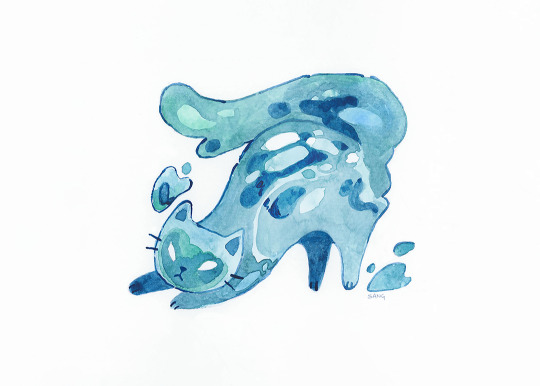
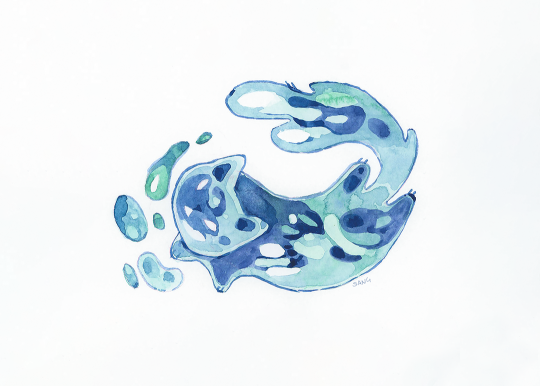
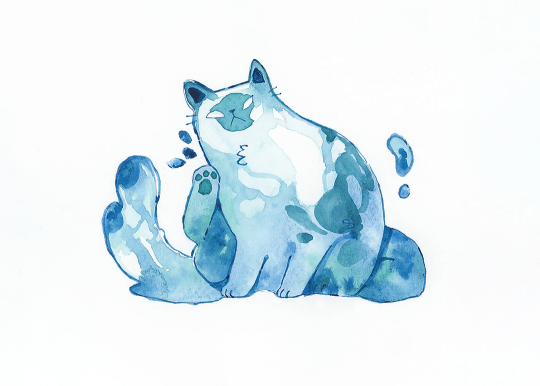
water droplets
#watercolor#illustration#traditional painting#cat#been practicing how to stylize water#it's hard but really fun#a friend gave me a copy of jan hart's watercolor guide too#which has been extremely helpful
12K notes
·
View notes
Text
warrior cat designs based on those fuckass ultimate guide color palettes
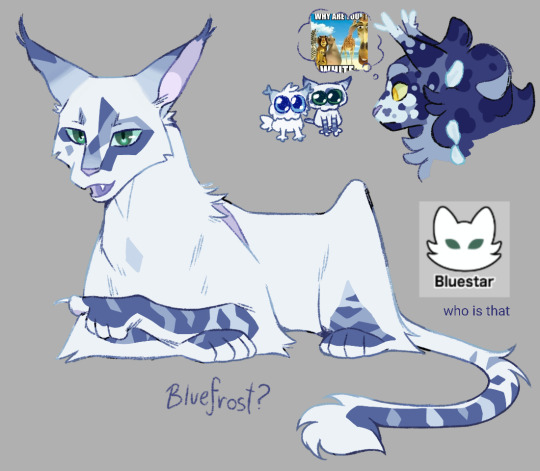


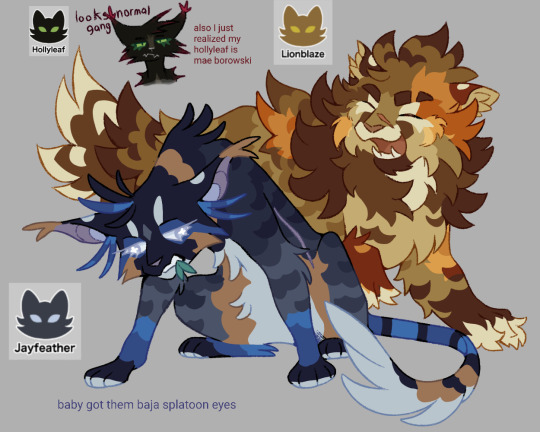
Swatch diagrams made by @/Sunnyfall , please look at them because what was happening behind the curtains that lead to cinderheart being blonde and ivypool brown
#hello warriors fandom i havent read a book in years#this entire thing is funny because whoever chose those swatches clearly had 0 idea what was going on#yellowfang ivypool and runningnose all have the same colour and its Not gray#art#bluestar#leafstar#dovewing#jayfeather#lionblaze#warriors#moonflower#hollyleaf#wc#warrior cats#wc designs#warrior cats designs#warrior cat designs#my 12yo self leapt at the opportunity to draw the murder cats again#warriors ultimate guide
5K notes
·
View notes
Text
youtube
#cats#cat breeds#cat behavior#cat guide#cat advice#catcare#cat owner#cat care#cat purring#cat by nigth#cat secret#cat daddy#cat expert#funny cats#cat videos#Youtube
1 note
·
View note
Text

are you lost?
#kitty cat will guide you dear traveller!#this was a whole lot of fun!!!#original art#digital artist#digital art#cat#kitty#artists on tumblr#artwork#art#likelyart#plants
1K notes
·
View notes
Text
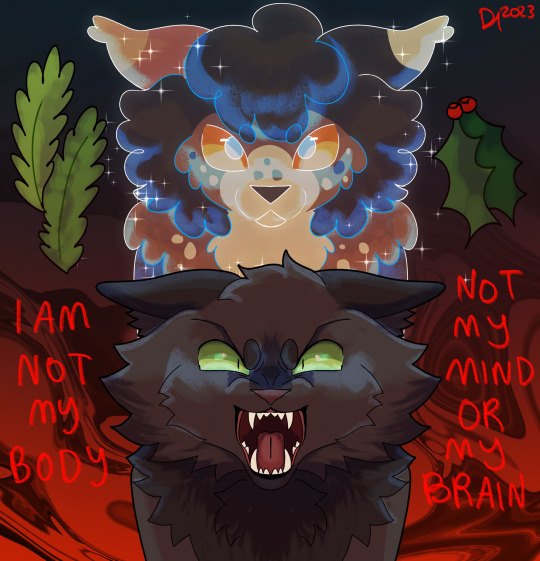
eye of the storm
#wc#warrior cats#warriors#waca#warriors fanart#thunderclan#hollyleaf#spottedleaf#what if spottedleaf guided holly instead of jay#even helped her kill ashfur because she felt guilty for making leafpool gaving to lie for the first place#these two deserve to kill men!!!
2K notes
·
View notes
Text

ThunderClan

RiverClan

WindClan

ShadowClan
4K notes
·
View notes
Text

"Even if your eyes worked you still would not be able to see the TRUTH"
My finished Jayfeather & Rock illustration for @harriertail Ultimate Guide Zine!
#mini holo prints in the shop ✨️#artists on tumblr#digital art#digital artists#illustration#kids lit#artist alley#warrior cats#wc#wc fanart#warrior cats fanart#erin hunter#jayfeather#power of three#thunderclan#ultimate guide zine#climbdraws
2K notes
·
View notes
Text
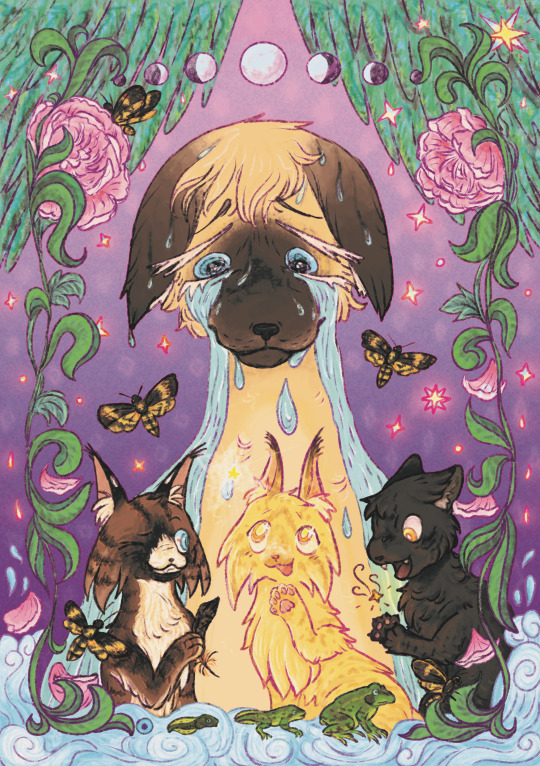
My Piece for @harriertail 's Ultimate Guide Zine!
I got Sasha and her kits <3 I had sooo so much fun!!
Below are some wip pictures + my thoughts behind the piece!!!
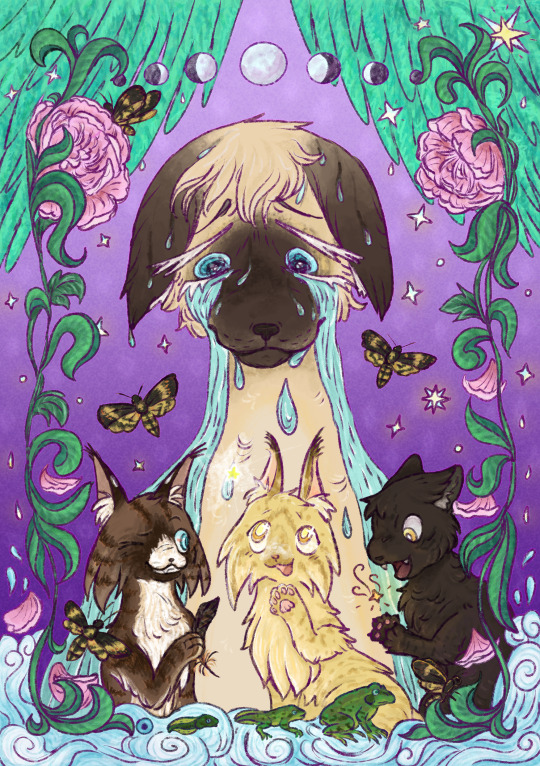
the RGB Version! The lineart isn't colored in properly here.
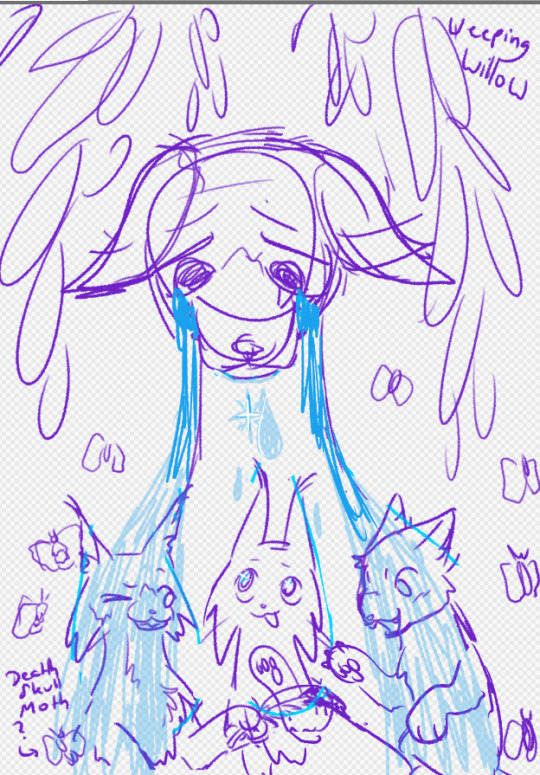
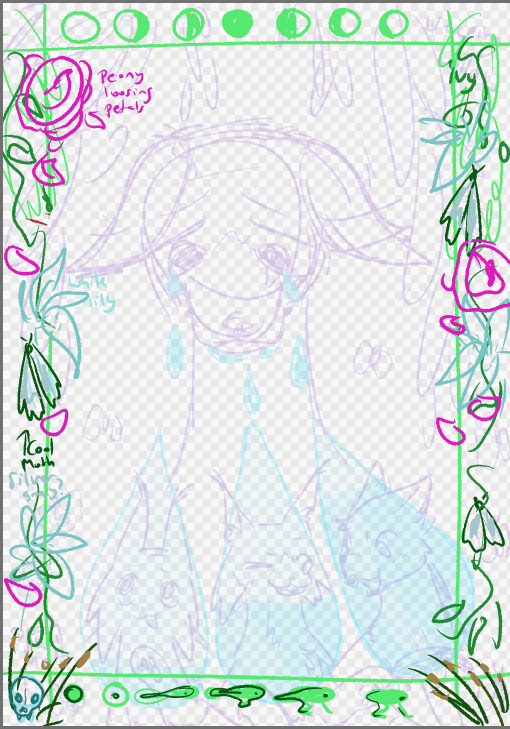


Some earlier Concepts + sketches!

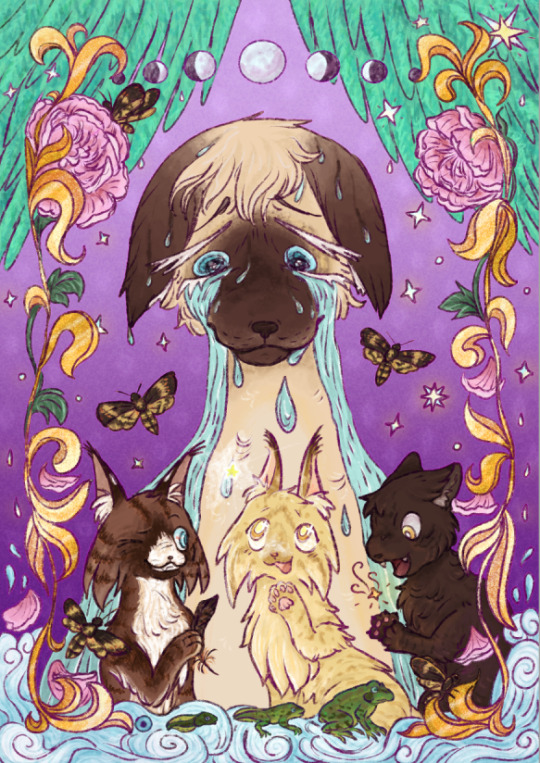
Many Sashas.. and originally the leaves were supposed to be golden, but it didn't fit well.
Some thoughts:
What i love about Sasha is just how tied to water her life is-yes i enjoyed her Manga a lot, my poor little miserable women <3
First off all, she leaves her happy life as a ships-cat to raise her children. Tadpole drowns early in their lives, putting a Shadow over their happiness. They leave for RIVERclan- where Hawkfrost will die in the Lake while Mothwing lives out a life she is not the happiest with. Its why she is looking at a Star-she may be the last one alive and at first, a life as a medicine cat seemed to be everything she wanted, until she found out about Hawkfrosts Manipulation.
Tadpole holds a star because he is the strongest kit, yet dies first.
The three are symbolised by a feather, the evolution of the frog and death's-head hawkmoth- symbols of death, obviously.
Willows grow around bodies of water and are often symbols of grief.
Meanwhile Sasha can only look down and with the passage of time (-> moon phases changing) see and know that in the end, her trying to save her children doomed them, and do nothing about it but cry.
Kinda depressing stuff for a little kitty in a book :,D
if you read my thoughts, thank you so much! I hope everyone enjoys their copy of the Ultimate guide zine. Heres a treat for you: 🐱🌿 (catnip)
#warriorcats#warrior cats ultimate guide zine#warriors#warrior cats#mothwing#hawkfrost#Sasha#sasha warrior cats#warriors sasha#wc sasha#tadpole wc#warriors tadpole#warriorcats tadpole#zine#zine art#warriorcats art#zine artist#warrior cats mothwing#warriorcats hawkfrost#hawkkit#mothkit
2K notes
·
View notes
Text

Local urban development scheme makes efforts to shelter millions of homeless children across the country within three months
#I'm so EXCITED I LOVE BUILDING AND CUSTOMISING THINGS#It messes with my headcanon that sky children are like cats in the sense that they won't just be living wherever anymore#BUT#I wamt haus#I'm gonna try and make mine at least a little silly like a zoo enclosure because I want to climb and lie on top of things#Totally not projecting at all#:3#Season of nesting#Nesting Guide#sky children of the light#sky: cotl#that sky game#sky cotl#sky: children of the light#sky game#skyblr#skykid#IKEA#Meme
802 notes
·
View notes
Text

YOU HAD ONE JOB
(edit: before anyone questions that the wiki itself would have the artworks backwards, they don't, as these novella icons have been used on their profiles on the warriors site before. This is just kinda funny)
1K notes
·
View notes
Text
Warrior Bites: Dietary Needs
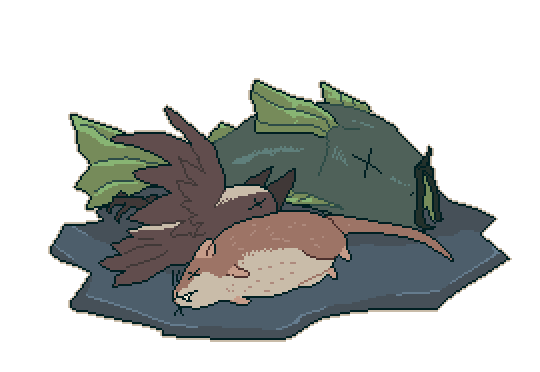
[ID: A fish carcass, bird carcass, and mouse carcass on a stone slab.]
Are you wondering how much prey a Clan needs a day? What they should eat to stay healthy? Why food processing is useful at all? All the answers to these questions and more, contained within a general guide to dietary needs for your Warrior Cats!
As an obligate carnivore, a cat's entire diet revolves around processing meat. More specifically, the ideal diet should be 55% protein, 45% fats, about 1% to 3% carbs, with the remainder being various micro-nutrients. You can expect the average 10-pound warrior to need 350 calories per day, about 3.5 mice on average.
I've also included a section talking about obesity, which dives into how canon's depiction of it is both harmful fatphobia and wouldn't make sense from a cat perspective. It also discusses obesity in realistic cats; and how you're free to choose the realism on that aspect.
Below the cut;
Caloric Intake
Nutrition
Food Processing
On Obesity
Caloric Intake
The general rule for how much a cat needs to eat is that an active, non-neutered tom will need about 35 calories per pound of their own body weight, per day, just to remain the weight they are.
That means that the average warrior, assuming they are 10 pounds, will need 350 calories a day.
Kittens, pregnant and nursing cats, and large warriors will need to eat more than average. Neutered cats, elders, and clerics/medcats will eat less. There are calculators online for determining how much an individual will need, but you can estimate how much an entire Clan will need just by taking 350 and multiplying it by population!
Assuming the average population is about 30 cats, that's 10,500 calories to feed a Clan for a day! To put that in perspective, that many calories would feed 7 large humans. If you felt like fighting a group of angry cats to steal their day's worth of mice, I mean.
Generally speaking, land prey will have a caloric value around 5 calories per gram. Aquatic prey is significantly lower, around 4 calories per gram. Birds will be just below 6 calories per gram. To find out how many cats a piece of prey will feed, or how many pieces a cat will need that day, take the category and multiply by the prey's weight in grams.
So for example, the average house mouse is 20 grams and it is land prey, meaning its caloric value is around 100 calories! A warrior will need 3 and a half mice a day to stay healthy, and a Clan will need 105 mice daily to support 30 cats.
105 mice may seem like a lot, but remember that a wild rabbit is 1,800 grams on average which means 9,000 calories. 2 big pieces of prey will feed the whole Clan, with leftovers.
Those estimates include every part of the animal. Cats eat organs, small bones, and even skin. Skeletal muscle, or "fillets" in reference to fish, is so low in calories that it's typically somewhere between 1 kcal to 1.5 kcal per gram. That's what you're buying in the supermarket; but wild animals don't usually cut their food into choice strips.
(unless you're writing a clan that does food processing of course!)
QUICK FACTS
Average warrior will need 35 calories per pound of weight
10 pound warrior needs 350 calories a day
350 x 30 cats = 10,500 calories to feed a Clan for a single day
Birds provide the most calories per gram, land prey the middlemost, and aquatic prey the least.
Calculate calories in prey by taking the weight, converting to grams, and multiply by 4, 5, or 6 depending on broad category.
If you're having trouble feeding a Clan on small animals, look at bigger prey like rabbits and trout.
Muscle fillets are inferior to organ meats and have a much lower caloric value.
Nutrition
Not all food is the same. The more important thing to consider about any particular meal is NOT its calorie count, but its nutritional value. This is especially important to cats because protein is not stored as fat. If the body has no immediate use for it, it's flushed out.
Since cats should not eat more than 3% carbs, ALL of their fat stores will need to come from fat.
The ideal piece of meat would be at least 55% protein and 45% fat. Every individual species will have a different ratio, and more importantly, individual cuts will have a different ratio.
Skeletal muscle has a higher ratio of protein to fat. Organ meat, also sometimes called "offal," will have a more balanced ratio. That said, nearly all meat skews towards protein. PURE fat is very hard to find on the sorts of animals Clan cats hunt, and must be carefully divided, collected, or processed to make sure all warriors are getting proper nutrition.
I'll be going more in-depth with dietary fat at some other time, as this guide is meant to just be an overview! Just know that some Clans will need to eat MORE food to stay healthy because of this.
Cats need more than the "macronutrients" to stay healthy. They can't JUST rely on the juiciest cuts of meat to keep their health intact, they also need several vitamins and minerals to support their body functions, and avoid getting a deficiency.
Here's some of the important micronutrients, where to get them, and what happens they don't get enough;
Vitamin A: Livers, mealworms, eggs
This is one of the most important micronutrients in a cat's body, used for practically everything. Without this, their coats will grow dull, and their joints stiff, and they'll start to go night-blind. In a severe state, they'll start to lose the ability to heal skin lacerations and die. Pregnant cats and kittens need more of this than usual, but it IS also possible to get vitamin A poisoning from getting too concentrated of a dose.
Calcium: Bones, eggs
With a calcium deficiency, the warrior will feel stiff and sore, and experience painful muscle spasms. Most cats will simply crunch the bones of small prey and never have to worry about this, but if your cats cook or scavenge, they have to be told to NEVER eat the bones of a roasted bird. Because bird bones are hollow and cooking makes them brittle, they can splinter and cause fatal internal bleeding.
Thiamine: Trout, boar meat, mealworms, eggs
Called a Fish Seizure because raw carp and raw bream contains thiaminase, which will destroy thiamine in the body. Lack of thiamine will cause neurological issues, such as the aforementioned seizures, general confusion, memory loss, and muscle weakness. This can be counterracted by eating trout, which is so high in thiamine that there's a theory that carp evolved it specifically to eat salmonids better.
Potassium: Trout, boar meat, mealworms, eggs
As cats get older, they begin needing a lot more potassium for their bodies. It's a very common micronutrient found in most meat, but elders should get the first bite of special snacks "out of respect" which helps keep their potassium level up. Without it, they become very weak.
i feel like that evil struthiomimus from land before time with how many times i typed eggs
QUICK FACTS
The ideal ratio of a cut of meat is 55% protein 45% fat
Organ meat > Muscle meat
Micronutrients are important
But micronutrients can also cause poisoning if, somehow, they're too concentrated
(very hard to come across concentrated micronutrients without the science of chemistry tho. Like if a cat swallowed a vitamin gummy.)
Food Processing
"Food Processing" is when you do something to your food before you eat it. Just a little bit of care is going to go a LONG WAY when it comes to health of the warrior.
Cats that eat raw meat the way canon warriors do are almost guaranteed to get worms. Roundworms, hookworms, and tapeworms are all passed through the infected tissue of rodent prey, and in fish, roundworms, tapeworms, and flukes can pass through raw meat.
All parasites do something a little different, but most digestive worms aren't fatal unless the cat is sick or a kitten. However, nearly ALL of them screw around with digestion, making the cat need to eat more just to stay healthy, or causing stomach irritation. Some of them can even pass in milk, infecting a suckler's nursing kits.
The easiest way to reduce this kind of infection is simply to slice the prey open from mouth-to-butt, Tigerstar-style, and hook and lift out the GI tract before eating. There's nothing in that worth eating raw anyway. It can just be discarded, or cleaned out and used to case tiny sausages! But it's only a reduction; there's still a risk of catching worms from raw meat.
There's also always the possibility of getting salmonella poisoning.
Many believe that cats are immune to this, but that's not true! Carnivores just have a shorter GI tract than omnivores and herbivores, so salmonella spends less time in their gut and ergo has less chance of causing an infection. It still happens, ESPECIALLY when cats hunt songbirds.
Nothing can be done about salmonella in raw meat, besides eating it as quickly as possible. It's innate to the bodies of birds and reptiles, and usually found on raw eggs too.
Some animals are small enough to be dried and carried around as rations, such as minnows or grasshoppers. Others could be sliced up into strips, and marinated in spices like valerian or catmint for an extra boost of energy. It could also be worthwhile to cut the pelt off a particularly soft animal, like a mole, to dry and keep as bedding material.
All of the above examples of food processing are possible without fire, but if your cats DO have fire, they will have a DRASTIC increase to the quality of their health.
Such as;
Cooking will almost completely eliminate those foodborne parasites. Their eggs don't survive extreme heat.
No more salmonella poisoning! GONE! Cooking is the only way to eliminate this!
It can increase caloric absorption from anywhere between 20% to 50%. Our example warrior who needed 3.5 mice a day could suddenly need one less mouse; and even a meager 20% drop in how much the entire Clan needs saves 2,400 calories a day. 24 whole mice!
I HAVE TO STRESS HOW BIG THAT IS. You save anywhere from 2/10 to 5/10 successful kills.
Thiaminase is destroyed by cooking, making bream and carp healthier and reducing "fish seizures."
It allows for fats to be processed and stored as tallow, lard, and oil, so it can be added to other dishes to make them both healthier and tastier.
Most food preservation requires fire in some way; by heating, jellying, boiling, etc. The only other two ways to reliably store food is by having access to a ton of salt, which is hard for most non-coastal clans to acquire, or vinegar, which is so acidic it's a notorious cat-repellent.
While cooking can also destroy some micronutrients, its benefits FAR outweigh any potential "strengths" of raw food. Destroying micronutrients is also not always a bad thing; as TOO MANY micronutrients can cause poisoning. Fire-using Clans will be more likely to "seek" micronutrients than non-fire Clans as a result, though they probably won't recognize the science behind a hankering!
QUICK FACTS
Worms. Basically unavoidable if your cat's eating like a canon warrior.
Some parasites can spread through milk.
Slicing and lifting out the GI tract can significantly reduce the chance of catching worms.
Salmonella can only be eliminated with cooking
Cooking will drastically increase the quality of a Clan's health, if your cats are advanced enough to figure out fire.
Warriors need to hunt a LOT less prey, and can store that prey, if they have fire.
Fire-using Clans will intentionally try to put more types of food in their diets and get 'cravings.'
On Obesity
Warrior Cats is not a realistic series. The boundary that any particular writer draws between humans and warrior cats is completely arbitrary. The series itself follows no sense of realistic genetics, regularly shows the cats using herbs that would poison them, and gives the characters human-centric morals like monogamy and paternal involvement.
So when it comes to being fatness in your project, please keep that in mind. You do not need too follow realistic cat weight distribution, if that's not what your project about. That said, let me tell you about humans vs cats in this department!
Humans have a massive diversity of weight distribution, with varied genetic predispositions to gaining and losing weight. The shame, bullying, and medical discrimination that comes with fatphobia is a LOT more harmful than being fat itself, and the causes of the "obesity crisis" are ridiculously more complicated than "ppl r snorking 2 much food".
Realistic cats aren't the same way.
When REAL cats are fat, that's VERY bad. It's a sign they are being fed the wrong things by humans, or live somewhere that they are able to eat what they shouldn't. They just don't have that same diversity in fat distribution that humans do. Because of how adipose tissue secretes certain hormones, feline obesity is like a chronic inflammatory disease which can cause arthritis, bladder stones, hepatic lipidosis, and more.
But with that in mind, fatness should be perceived very differently even in the most realistic settings. In comparison to humans;
It is harder for a wild cat to put on weight.
Most of what they're eating is raw protein, actively trying to fill the 45% of daily fat intake they need to stay healthy. Protein isn't stored as fat, it's immediately discarded by the body if there is no use for it. A cat would need to be taking an INSANE amount of prey to start becoming dangerously overweight.
Housecats are often fed human food, which has carbohydrates. Low-quality cat food will also use carbs as filler. High carb food is VERY bad for them, since they're only supposed to have 3% carbs at most. This is one of the reasons why it's easy for pet cats to become overweight.
Realistic cats don't look start looking overweight until they are significantly obese.
Most of their fat is stored around their ribs and internally, unlike humans with our thick hips and round bellies, and they are covered in a naturally sagging pelt of fur. It's not as obvious with them. Visually, weight will be noticed best from a bird's eye perspective, unlike humans where it's apparent at every angle.
Putting on the fat that CAN be acquired is ridiculously important
3.5 raw, whole mice a day, per cat, are needed to fill their basic dietary requirements. There are going to be days or months especially during winter where they might be below that number, and that stored fat is going to be lifesaving. Bulking up is actually a big deal!
So not only is how canon treats overweight characters full of malice, it's full of lazy malice. It makes no sense from a realistic standpoint for wild cats to develop an association between fatness and greed or laziness. It's important, hard work for them to acquire it!
Though the Clans are notoriously xenophobic and kittypets are more likely to be overweight, it still doesn't make sense from a realistic cat perspective to be fatphobic in the same way as canon. It's more likely they'd see fat housecats as having "unearned" weight given to them by humans, like they're cheating, or they might be disdainful of how much junk food they eat, or pitiable because it's a sign of a bad twoleg... or just "sour grapes" variety jealousy ☕.
Bottom line is that there's a LOT you can do here which is better than canon's vicious bullying. The writers just lifted British cultural disdain for fat people and put it into the books. They simply did not think it through.
So please do what they didn't, and just put a little extra thought into how your project is going to view fatness! Consider if fatphobia is even a theme you need in your text.
As stated, you do not even have to write weight in your cats as being realistic in this way! I encourage you to pick and choose what's most fun and fitting for your own work. I personally give my characters a more human weight distribution, simply because I want to spite canon and be more body-positive. I am a fat people and you can take Bumble's big chunky bod from my cold, dead hands.
You can choose to make your work however you'd like, and now with this guide, you can have an easy reference for what your cats should eat! Thank you, StarClan, for this prey <3
#Clan culture#warrior cats#Fatphobia#Cw fatphobia#tw fatphobia#Nutrition#Prey#Food#Bonefall's Clan Culture#Food guide#Nutrition guide#Gamer-the-kittypet art#Also if there are any devs or modders out there who wanted to add food values to any games that involve cats#Please feel free to use this guide as all my work is open-source#I can explain how I came to those values and work out some more accurate numbers if you end up needing them#animal death#cw animal death#tw animal death#cw parasites#tw parasites#parasites#Warrior bites
624 notes
·
View notes